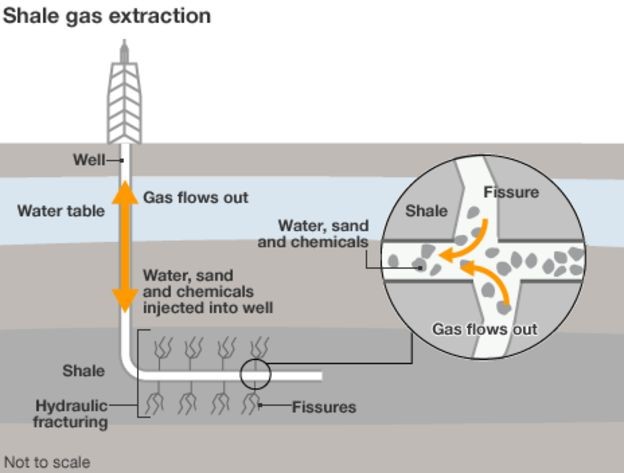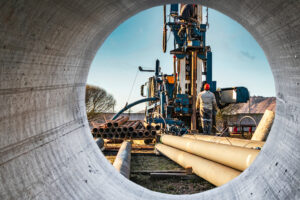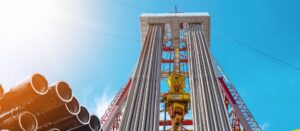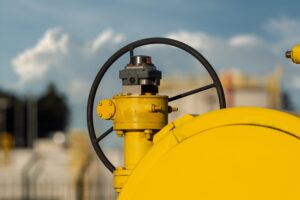Hydraulic Fracturing, more commonly known as fracking, is a somewhat controversial and often misunderstood process of accessing natural gasses. Understanding the pros and cons of fracking is important. You must know what it is, how it works, and its potential risks and benefits.
What is Fracking?
First, you need to understand what fracking is. According to the Merriam-Webster Dictionary, fracking is “the injection of fluid into shale beds at high pressure to free up petroleum resources such as oil or natural gas”.
How Does Fracking Work?
A vertical well is drilled into the ground until it reaches penetrable shale layers. The digging will eventually reach layers of shale with small gaps and fissures rich with natural gasses, at which point the digging will begin in a horizontal direction into the rock. The digging is now at an angle parallel to the ground and usually between 7,000 and 12,000 feet deep. 4-6 wells can be dug on one pad or site, depending on the number of gasses in the rock below.
To protect the well from collapse, the well will be surrounded by a steel casing. If the drilling goes past the aquifer, it will be surrounded by both steel and concrete for further stabilization.

Introducing Pressurized Fluids
Once the well is secure, fracking fluid is pumped into the well. This fluid is mostly water and sand with a mixture of chemicals and is pumped in at a high-pressure rate with a pumping tank. The fluid is forced into the gaps and fissures.
Fracturing the Shale Rock
The fluid forced into the shale rock will cause it to crack and the fracking fluid will come back up to the surface. The fluid is then collected and moved to a treatment plant. Yet, as soon as the fluid is removed the fissures and crevices will attempt to close.
Keeping the Fractures Open
The goal now is to keep the fractures open in the shale. The use of proppants keeps the fracture open. When you consider the sheer pressure of the shale rock surrounding the cracks and fissures, it stands to reason that the proppants have to be very strong and stable.
Collection of Gas
Now that the fractures are propped open, the natural gases can escape from the shale layers. The shale flows up from the fissures and into the well.
Storage of the Natural Gas
The gas will then be moved from the well into storage tanks until it can be piped to the market.
After Fracking is Completed
These wells may produce for 20-40 years. All rigs and drilling equipment are removed when the well has stopped producing. The area that is disturbed by fracking will be reclaimed and restored. This restoration means different things in different areas.
The Benefits of Fracking
There are many benefits to fracking that are often overlooked. Even those who tend to be against fracking overall may find that the benefits mitigate some of the risk associated with it.
Access to Oil and Gas
Simply put, fracking gives us access to natural deposits of gas that we have long known were there, but we didn’t have other means to extract it. Being able to tap into these resources helps to lower the cost of gas.
Because oil is now in more abundant supply, gas prices have plummeted, making consumers happy at the pump. Additionally, consumers can heat their homes for much less than they did before fracking began.
Time to Plan
It’s been known for ages that fossil fuels are non-renewable. Eventually, we are going to run out of them. Fracking is buying us some time until we can find safe alternatives to heat, cool, and power our homes and cars. For now, fracking is giving us more access to fossil fuels that we need until we can begin consuming other sources of energy.
More Self Reliant
Unfortunately, fossil fuels are not evenly distributed around the world so every country can supply their own fossil fuel needs. The United States has become much more self-reliant since fracking; we don’t have to rely on foreign countries to provide us with all our fossil fuels. Being able to supply ourselves with at least some of the fuels we need has been beneficial and in the long run, could ease tensions around the world.
Employment Opportunity
The increase in the production of natural gas has created more jobs. The number of people employed by the oil and gas industry is massive. In fact, 1.4 million people in the United States alone are employed by the industry specifically in the areas of extraction, production, refining, and distribution.
Reduction of Air Pollution
While there is a concern that fracking is not good for the environment, we can reduce the amount of air pollution if we continue to use natural gases instead of burning oil and coal. Burning coal releases carbon dioxide and sulfur into the air, while the burning of gas doesn’t release toxins at the same rate as coal. Though fracking is controversial, compared to coal and oil the consumption of gas is a better option when we consider how to slow the process of global warming.
The Concerns Associated with Fracking
If you have looked at the process and now at the benefits, you may be wondering where the controversy is?

With all good things, there are potential pitfalls. We must weigh the good with the bad. There are some potential concerns that we need to consider with continued fracking practices.
Water Pollution
Water pollution is a big concern linked to the knowledge that fracking water is full of potentially dangerous chemicals. While most of the water is pumped out of the well and the fissures, in some cases, the water does not rise back to the surface. Instead, water seeps down and potentially pollutes lakes, ponds, and even the ocean where people and animals can be adversely affected.
Air Pollution
Air pollution is another real concern associated with fracking. After the drilling process has been completed but before the gases are collected, known carcinogens benzene and methane may leak from the ground. The chemicals seep into the air potentially cause health-related problems.
Water Consumption
Sand and water are used in fracking with chemical additives. Water usage is a key concern related to fracking. It is estimated to take 1-8 million gallons of water to complete a fracturing job. When you consider that there are upwards of 500,000 active natural gas wells associated with fracking, the consumption is 72 trillion gallons of water in the United States alone. With many cites already facing water shortages, this is a legitimate concern.
A Fluid Situation
In the year of a Presidential election, we are sure to hear more about fracking as this is a controversial topic in politics. As global warming remains a hot button issue and many associate it with fracking, we are likely to see more discussions about fracking, it’s future, and it’s environmental and economic implications.
Here at MSI Pipe Protection Technologies, we want to keep you up to date on all aspects of the oil and gas industry and fracking seems to be particularly relevant right now.




